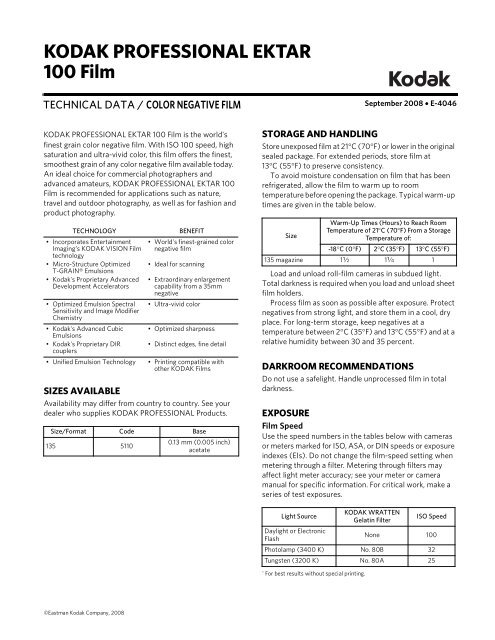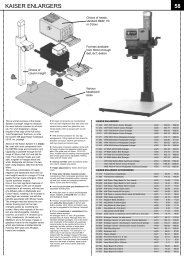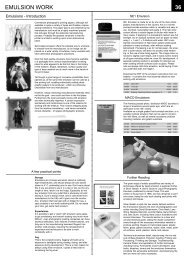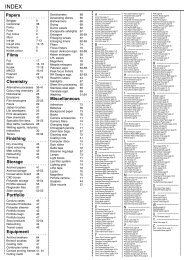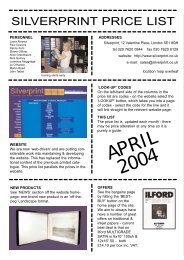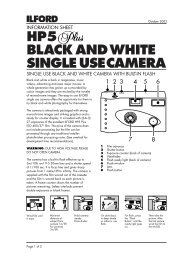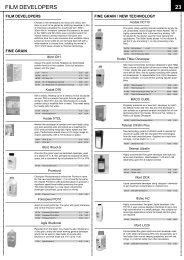KODAK PROFESSIONAL EKTAR 100 Film - Silverprint
KODAK PROFESSIONAL EKTAR 100 Film - Silverprint
KODAK PROFESSIONAL EKTAR 100 Film - Silverprint
You also want an ePaper? Increase the reach of your titles
YUMPU automatically turns print PDFs into web optimized ePapers that Google loves.
<strong>KODAK</strong> <strong>PROFESSIONAL</strong> <strong>EKTAR</strong><br />
<strong>100</strong> <strong>Film</strong><br />
TECHNICAL DATA / COLOR NEGATIVE FILM<br />
<strong>KODAK</strong> <strong>PROFESSIONAL</strong> <strong>EKTAR</strong> <strong>100</strong> <strong>Film</strong> is the world's<br />
finest grain color negative film. With ISO <strong>100</strong> speed, high<br />
saturation and ultra-vivid color, this film offers the finest,<br />
smoothest grain of any color negative film available today.<br />
An ideal choice for commercial photographers and<br />
advanced amateurs, <strong>KODAK</strong> <strong>PROFESSIONAL</strong> <strong>EKTAR</strong> <strong>100</strong><br />
<strong>Film</strong> is recommended for applications such as nature,<br />
travel and outdoor photography, as well as for fashion and<br />
product photography.<br />
TECHNOLOGY BENEFIT<br />
• Incorporates Entertainment<br />
Imaging’s <strong>KODAK</strong> VISION <strong>Film</strong><br />
technology<br />
• Micro-Structure Optimized<br />
T-GRAIN® Emulsions<br />
• Kodak's Proprietary Advanced<br />
Development Accelerators<br />
• Optimized Emulsion Spectral<br />
Sensitivity and Image Modifier<br />
Chemistry<br />
SIZES AVAILABLE<br />
Availability may differ from country to country. See your<br />
dealer who supplies <strong>KODAK</strong> <strong>PROFESSIONAL</strong> Products.<br />
©Eastman Kodak Company, 2008<br />
• World's finest-grained color<br />
negative film<br />
• Ideal for scanning<br />
• Extraordinary enlargement<br />
capability from a 35mm<br />
negative<br />
• Ultra-vivid color<br />
• Kodak's Advanced Cubic • Optimized sharpness<br />
Emulsions<br />
• Kodak's Proprietary DIR • Distinct edges, fine detail<br />
couplers<br />
• Unified Emulsion Technology • Printing compatible with<br />
other <strong>KODAK</strong> <strong>Film</strong>s<br />
Size/Format Code Base<br />
135 5110<br />
0.13 mm (0.005 inch)<br />
acetate<br />
September 2008 • E-4046<br />
STORAGE AND HANDLING<br />
Store unexposed film at 21°C (70°F) or lower in the original<br />
sealed package. For extended periods, store film at<br />
13°C (55°F) to preserve consistency.<br />
To avoid moisture condensation on film that has been<br />
refrigerated, allow the film to warm up to room<br />
temperature before opening the package. Typical warm-up<br />
times are given in the table below.<br />
Size<br />
Load and unload roll-film cameras in subdued light.<br />
Total darkness is required when you load and unload sheet<br />
film holders.<br />
Process film as soon as possible after exposure. Protect<br />
negatives from strong light, and store them in a cool, dry<br />
place. For long-term storage, keep negatives at a<br />
temperature between 2°C (35°F) and 13°C (55°F) and at a<br />
relative humidity between 30 and 35 percent.<br />
DARKROOM RECOMMENDATIONS<br />
Do not use a safelight. Handle unprocessed film in total<br />
darkness.<br />
EXPOSURE<br />
<strong>Film</strong> Speed<br />
Use the speed numbers in the tables below with cameras<br />
or meters marked for ISO, ASA, or DIN speeds or exposure<br />
indexes (EIs). Do not change the film-speed setting when<br />
metering through a filter. Metering through filters may<br />
affect light meter accuracy; see your meter or camera<br />
manual for specific information. For critical work, make a<br />
series of test exposures.<br />
* For best results without special printing.<br />
Warm-Up Times (Hours) to Reach Room<br />
Temperature of 21°C (70°F) From a Storage<br />
Temperature of:<br />
-18°C (0°F) 2°C (35°F) 13°C (55°F)<br />
135 magazine 1 1 ⁄2 1 1 ⁄4 1<br />
Light Source<br />
<strong>KODAK</strong> WRATTEN<br />
Gelatin Filter<br />
ISO Speed<br />
Daylight or Electronic<br />
Flash<br />
None <strong>100</strong><br />
Photolamp (3400 K) No. 80B 32<br />
Tungsten (3200 K) No. 80A 25
Daylight<br />
Use the exposures in the table below for average frontlit<br />
subjects from 2 hours after sunrise to 2 hours before<br />
sunset.<br />
Lighting Conditions<br />
Bright or Hazy Sun on Light Sand or<br />
Snow<br />
* Use f/5.6 for backlit close-up subjects.<br />
† Use f/8 for backlit close-up subjects.<br />
‡ Subject shaded from the sun but lighted by a large area of sky.<br />
Adjustments for Long and Short Exposures<br />
No filter correction or exposure compensation is required<br />
for exposures from 1⁄10,000 second to 1 second. For critical<br />
applications with longer exposure times, make tests under<br />
your conditions.<br />
Electronic Flash<br />
Use the appropriate guide number in the table below as<br />
starting-point recommendations for your equipment.<br />
Select the unit output closest to the number given by your<br />
flash manufacturer. Then find the guide number for feet or<br />
metres. To determine the lens opening, divide the guide<br />
number by the flash-to-subject distance. If negatives are<br />
consistently too dense (overexposed), use a higher guide<br />
number; if they are too thin (underexposed), use a lower<br />
number.<br />
* BCPS = beam candlepower seconds<br />
Shutter Speed (second)<br />
and Lens Opening<br />
1/125<br />
f/16<br />
Bright or Hazy Sun (Distinct Shadows) 1/125<br />
f/11 *<br />
Weak, Hazy Sun<br />
(Soft Shadows)<br />
Cloudy Bright<br />
(No Shadows)<br />
1/125<br />
f/8<br />
1/125<br />
f/5.6<br />
Heavy Overcast or Open Shade ‡ 1/125<br />
f/4<br />
Unit<br />
Output<br />
(BCPS) *<br />
Guide Number<br />
Distances in Feet/Metres<br />
350 40/12<br />
500 50/15<br />
700 60/18<br />
<strong>100</strong>0 70/21<br />
1400 85/26<br />
2000 <strong>100</strong>/30<br />
2800 120/36<br />
4000 140/42<br />
5600 170/50<br />
8000 200/60<br />
Fluorescent and High-Intensity Discharge Lamps<br />
Use the color-compensating filters and exposure<br />
adjustments in the tables below as starting points to<br />
expose <strong>KODAK</strong> <strong>PROFESSIONAL</strong> <strong>EKTAR</strong> <strong>100</strong> <strong>Film</strong> under<br />
fluorescent or high-intensity discharge lamps. For critical<br />
applications, make a series of test exposures under your<br />
actual conditions.<br />
To avoid the brightness and color variations that occur<br />
during a single alternating-current cycle, use exposure<br />
times of 1⁄60 second or longer with fluorescent lamps; with<br />
high-intensity discharge lamps, use exposure times of<br />
1⁄125 second or longer.<br />
Type of Fluorescent Lamp<br />
<strong>KODAK</strong> Color<br />
Compensating<br />
Filter(s)<br />
Exposure<br />
Adjustment<br />
Daylight 20R + 5M +1 stop<br />
White 40B + 5C +1 2/3 stop<br />
Warm White 40B + 40C +2 stops<br />
Warm White Deluxe 40B + 50C +2 stops<br />
Cool White 30B +1 stop<br />
Cool White Deluxe 40C + 10M +1 stop<br />
High-Intensity Discharge<br />
Lamp (CCT)<br />
<strong>KODAK</strong> Color<br />
Compensating<br />
Filter(s)<br />
Exposure<br />
Adjustment<br />
High-Pressure Sodium<br />
Vapor<br />
50B + 70C +2 2/3 stops<br />
Metal Halide 5C + 10M +2/3 stop<br />
Mercury Vapor with<br />
Phosphor<br />
30B + 5C +1 stop<br />
Mercury Vapor without<br />
Phosphor<br />
80R +1 2/3 stop<br />
2 <strong>KODAK</strong> <strong>PROFESSIONAL</strong> <strong>EKTAR</strong> <strong>100</strong> <strong>Film</strong> • E-4046
PROCESSING<br />
Process <strong>EKTAR</strong> <strong>100</strong> <strong>Film</strong> in <strong>KODAK</strong> FLEXICOLOR<br />
Chemicals for Process C-41 using the replenishment and<br />
wash rates in the tables below. Note that the developer<br />
replenishment rates are starting-point recommendations<br />
only and may vary due to the amount of exposure to the<br />
film, scene content, and the presence/absence of sprocket<br />
holes.<br />
Replenishment and Wash Rates<br />
<strong>KODAK</strong><br />
FLEXICOLOR<br />
Developer<br />
Replenisher<br />
1012 mL/m 2<br />
94 mL/ft 2<br />
<strong>KODAK</strong><br />
FLEXICOLOR<br />
Developer<br />
Replenisher LORR<br />
506 mL/m 2<br />
47 mL/ft 2<br />
<strong>KODAK</strong><br />
FLEXICOLOR<br />
Bleach III,<br />
Fixer, and<br />
Stabilizer<br />
861 mL/m 2<br />
80 mL/ft 2<br />
Wash Water *<br />
31 L/m 2<br />
2.9 L/ft 2<br />
* Rates are for first wash and a two-stage countercurrent final wash. Double<br />
these rates for a single stage final wash.<br />
JUDGING NEGATIVE EXPOSURES<br />
You can check the exposure level with a suitable electronic<br />
densitometer equipped with a filter such as a <strong>KODAK</strong><br />
WRATTEN Gelatin Filter No. 92 or the red filter for<br />
Status M densitometry. Depending on the subject and the<br />
light source used for exposure, a normally exposed and<br />
processed color negative measured through the red filter<br />
should have the approximate densities listed below.<br />
Because of the extreme range in skin color, use these red<br />
density values for a normally lit forehead only as a guide.<br />
For best results, use a <strong>KODAK</strong> Gray Card (gray side).<br />
Area Measured Density Reading<br />
<strong>KODAK</strong> Gray Card (gray side) receiving<br />
0.77 to 0.87<br />
same illumination as subject<br />
Lightest step (darkest in the negative) of a<br />
<strong>KODAK</strong> Paper Gray Scale receiving same<br />
1.13 to 1.23<br />
illumination as subject<br />
Highest diffuse density on normally lighted<br />
forehead<br />
—light complexion<br />
—dark complexion<br />
1.08 to 1.18<br />
0.93 to 1.03<br />
RETOUCHING<br />
Retouch only the emulsion side of 135 size film.<br />
For information on retouching equipment, supplies, and<br />
techniques, see <strong>KODAK</strong> Publication No. E-71, Retouching<br />
Color Negatives.<br />
PRINTING NEGATIVES<br />
This film is optimized for printing on <strong>KODAK</strong><br />
<strong>PROFESSIONAL</strong> SUPRA ENDURA, SUPRA ENDURA VC<br />
Digital, ULTRA ENDURA, ULTRA ENDURA High Definition,<br />
and PRO IMAGE II Papers, and on <strong>KODAK</strong> <strong>PROFESSIONAL</strong><br />
ENDURA Metallic Paper.<br />
Make color slides and transparencies by printing the<br />
negatives on <strong>KODAK</strong> <strong>PROFESSIONAL</strong> ENDURA<br />
Transparency Display Material or <strong>KODAK</strong><br />
<strong>PROFESSIONAL</strong> ENDURA Clear Display Material.<br />
Make black-and-white prints on any of the materials<br />
mentioned above using the recommendations in <strong>KODAK</strong><br />
Publication CIS-274, Printing Black-and-White Images<br />
Without <strong>KODAK</strong> Black-and-White Papers.<br />
To set up a color printer or negative analyzer, use the<br />
following control negatives.<br />
<strong>KODAK</strong> <strong>PROFESSIONAL</strong> PORTRA Printer<br />
Control Negative<br />
CAT No.<br />
Set / Size 135 * 179 8511<br />
* This set includes one each: very under, under, normal, over, and very over<br />
negatives.<br />
Digital Files<br />
You can scan your image to a file and print digitally to —<br />
<strong>KODAK</strong> <strong>PROFESSIONAL</strong> ENDURA Metallic Paper<br />
<strong>KODAK</strong> <strong>PROFESSIONAL</strong> SUPRA ENDURA Paper<br />
<strong>KODAK</strong> <strong>PROFESSIONAL</strong> SUPRA ENDURA VC Digital<br />
Paper<br />
<strong>KODAK</strong> <strong>PROFESSIONAL</strong> ULTRA ENDURA Paper<br />
<strong>KODAK</strong> <strong>PROFESSIONAL</strong> ULTRA ENDURA High<br />
Definition Paper<br />
<strong>KODAK</strong> <strong>PROFESSIONAL</strong> PRO IMAGE II Paper<br />
<strong>KODAK</strong> <strong>PROFESSIONAL</strong> ENDURA Transparency<br />
Display Material<br />
<strong>KODAK</strong> <strong>PROFESSIONAL</strong> ENDURA Clear Display<br />
Material<br />
<strong>KODAK</strong> <strong>PROFESSIONAL</strong> <strong>EKTAR</strong> <strong>100</strong> <strong>Film</strong> • E-4046 3
SCANNING NEGATIVES<br />
You can easily scan <strong>EKTAR</strong> <strong>100</strong> <strong>Film</strong> negatives with a<br />
variety of linear-array-CCD, area-array-CCD, and PMT film<br />
scanners. You can scan negatives on desktop scanners as<br />
well as high-end drum scanners.<br />
Because no standards exist to define the colored filter<br />
sets that film scanners use to capture the red, green, and<br />
blue information of the film image, each manufacturer’s<br />
scanner has its own characteristic output. The output<br />
depends on the scanner’s sensitivity to the dyes in the film.<br />
This sensitivity is determined by the spectral distribution<br />
of the colored filter sets and/or the spectral sensitivity of<br />
the charge-coupled-device (CCD). In addition to these<br />
spectral specifications, scanner output depends on the<br />
look-up tables or matrices that the scanner uses to output<br />
information for CRT monitors, transmission, etc. These<br />
tables or matrices are part of either “plug-in” programs<br />
used with specific software packages designed for image<br />
manipulation, updateable ROMs included with the<br />
equipment, or fixed algorithms for calibrating and<br />
balancing, similar to those used in photographic color<br />
printing equipment.<br />
The generic “color negative film” channel designation<br />
available with scanner software is only a starting point.<br />
You can adjust the final color balance and the<br />
scene-dependent contrast and brightness of an image by<br />
using the scanner’s controls during pre-scan, or by using<br />
an image-manipulation software program or workstation<br />
after acquisition. Some scanners allow you to use “plug-in”<br />
programs to customize scanner setups.<br />
For more information, visit the following Web sites.<br />
To access Go to<br />
<strong>Film</strong> Terms for <strong>KODAK</strong><br />
PHOTO CD Imaging www.kodak.com/go/pcd<strong>Film</strong>Terms<br />
Workstations<br />
Drivers for <strong>KODAK</strong> <strong>Film</strong><br />
www.kodak.com/go/scannerDrivers<br />
Scanners<br />
IMAGE STRUCTURE<br />
Print Grain Index<br />
The Print Grain Index number refers to a method of<br />
defining graininess in a print made with diffuse-printing<br />
illumination. It replaces rms granularity and has a different<br />
scale which cannot be compared to rms granularity.<br />
• The method uses a uniform perceptual scale, with a<br />
change of four units equaling a just noticeable difference<br />
in graininess to 90 percent of observers.<br />
• A Print Grain Index rating of 25 on the scale represents<br />
the approximate visual threshold for graininess. A<br />
higher number indicates an increase in the amount of<br />
graininess observed.<br />
• The standardized inspection (print-to-viewer)<br />
distance for all print sizes is 14 inches, the typical<br />
viewing distance for a 4 x 6-inch print.<br />
• In practice, larger prints will likely be viewed from<br />
distances greater than 14 inches, which reduces<br />
apparent graininess.<br />
• Print Grain Index numbers may not represent<br />
graininess observed from more specular printing<br />
illuminants, such as condenser enlargers.<br />
Print Size in inches 4x6 8x10 16x20<br />
Magnification 4.4X 8.8X 17.8X<br />
Print Grain Index less than 25 * 38 66<br />
* 25 is the visual threshold for perception of grain.<br />
For more information, see <strong>KODAK</strong> Publication No.<br />
E-58, Print Grain Index—An Assessment of Print Graininess<br />
from Color Negative <strong>Film</strong>s.<br />
4 <strong>KODAK</strong> <strong>PROFESSIONAL</strong> <strong>EKTAR</strong> <strong>100</strong> <strong>Film</strong> • E-4046
CURVES<br />
LOG SENSITIVITY*<br />
DENSITY<br />
4.0<br />
3.0<br />
2.0<br />
1.0<br />
0.0<br />
-3.0<br />
E4046A<br />
3.0<br />
2.0<br />
1.0<br />
E4046B<br />
0.0<br />
250<br />
Characteristic Curves<br />
Exposure: Daylight<br />
Densitometry: Status M<br />
Log H Ref: -0.84<br />
-2.0<br />
-1.0 0.0 1.0 2.0<br />
LOG EXPOSURE (lux-seconds)<br />
Spectral-Sensitivity Curves<br />
Exposure: Daylight<br />
Effective Exposure: 1/25 Second<br />
Densitometry: Status M<br />
Density: 0.2>D-min<br />
300<br />
350<br />
Yellow-<br />
Forming<br />
Layer<br />
Magenta-<br />
Forming<br />
Layer<br />
400 450 500 550 600<br />
WAVELENGTH (nm)<br />
B<br />
G<br />
R<br />
Cyan-<br />
Forming<br />
Layer<br />
650<br />
*Sensitivity = reciprocal of exposure (erg/cm ) required<br />
to produce specified density<br />
2<br />
700 750<br />
Spectral-Dye-Density Curves<br />
Typical densities for a midscale neutral subject<br />
and D-min.<br />
Minimum Density<br />
Midscale Neutral<br />
Modulation Transfer Function<br />
5 <strong>KODAK</strong> <strong>PROFESSIONAL</strong> <strong>EKTAR</strong> <strong>100</strong> <strong>Film</strong> • E-4046<br />
RESPONSE (%)<br />
DIFFUSE SPECTRAL DENSITY<br />
2.5<br />
2.0<br />
1.5<br />
1.0<br />
0.5<br />
E4046C<br />
200<br />
<strong>100</strong><br />
70<br />
50<br />
10<br />
7<br />
0.0<br />
400<br />
30<br />
20<br />
5<br />
3<br />
2<br />
1<br />
E4046D<br />
450 500 550 600 650<br />
WAVELENGTH (nm)<br />
Exposure: Daylight<br />
Process: C-41<br />
700<br />
1 2 3 4 5 10 20 50 <strong>100</strong> 200 600<br />
SPATIAL FREQUENCY (cycles/mm)<br />
NOTICE: The sensitometric curves and data in this publication represent product tested<br />
under the conditions of exposure and processing specified. They are representative of<br />
production coatings, and therefore do not apply directly to a particular box or roll of<br />
photographic material. They do not represent standards or specifications that must be<br />
met by Eastman Kodak Company. The company reserves the right to change and<br />
improve product characteristics at any time.<br />
B<br />
G<br />
R
<strong>KODAK</strong> <strong>PROFESSIONAL</strong> <strong>EKTAR</strong> <strong>100</strong> <strong>Film</strong><br />
MORE INFORMATION<br />
Kodak has many publications to assist you with<br />
information on <strong>KODAK</strong> Products, Equipment, and<br />
Materials.<br />
The following publications are available from Kodak<br />
Customer Service, or you can contact Kodak in your<br />
country for more information.<br />
E-30 Storage and Care of <strong>KODAK</strong> Photographic<br />
Materials—Before and After Processing<br />
E-58 Print Grain Index<br />
E-71 Retouching Color Negatives<br />
E-4021 <strong>KODAK</strong> <strong>PROFESSIONAL</strong> PORTRA and SUPRA<br />
ENDURA Papers<br />
E-4020 <strong>KODAK</strong> <strong>PROFESSIONAL</strong> ULTRA ENDURA Paper<br />
E-4038 <strong>KODAK</strong> <strong>PROFESSIONAL</strong> ENDURA Transparency<br />
and Clear Display Materials<br />
E-4028 <strong>KODAK</strong> <strong>PROFESSIONAL</strong> ENDURA Metallic<br />
Paper<br />
E-4042 <strong>KODAK</strong> <strong>PROFESSIONAL</strong> SUPRA ENDURA VC<br />
Digital Paper<br />
E-4044 <strong>KODAK</strong> <strong>PROFESSIONAL</strong> ULTRA ENDURA High<br />
Definition Paper<br />
E-4002 <strong>KODAK</strong> <strong>PROFESSIONAL</strong> PRO IMAGE II Paper<br />
E-4040 <strong>KODAK</strong> <strong>PROFESSIONAL</strong> PORTRA <strong>Film</strong>s<br />
E-4035 <strong>KODAK</strong> <strong>PROFESSIONAL</strong> ULTRA COLOR <strong>100</strong>UC<br />
and 400UC <strong>Film</strong>s<br />
J-38 Using <strong>KODAK</strong> FLEXICOLOR Chemicals in<br />
Sink-Line, Bath, and Rotary-Tube Processors<br />
Z-131 Using <strong>KODAK</strong> FLEXICOLOR Chemicals<br />
Kodak, Kodak Professional, Ektar, Endura, Flexicolor, Pro Image, Portra, Supra, T-Grain,<br />
Ultra, Vision, and Wratten are trademarks.<br />
New 9-08<br />
Printed in U.S.A.<br />
<strong>KODAK</strong> <strong>PROFESSIONAL</strong> <strong>EKTAR</strong> <strong>100</strong><br />
<strong>Film</strong><br />
<strong>KODAK</strong> Publication No. E-4046<br />
<strong>Film</strong>, Photofinishing & Entertainment Group<br />
EASTMAN <strong>KODAK</strong> COMPANY • ROCHESTER, NY 14650<br />
For the latest version of technical support publications for <strong>KODAK</strong><br />
<strong>PROFESSIONAL</strong> Products, visit Kodak on-line at:<br />
http://www.kodak.com/go/professional<br />
If you have questions about <strong>KODAK</strong> <strong>PROFESSIONAL</strong> Products,<br />
call Kodak.<br />
In the U.S.A.:<br />
1-800-242-2424, Ext. 19, Monday–Friday<br />
9 a.m.–7 p.m. (Eastern time)<br />
In Canada:<br />
1-800-465-6325, Monday–Friday<br />
8 a.m.–5 p.m. (Eastern time)<br />
Note: The Kodak materials described in this publication for<br />
use with <strong>KODAK</strong> <strong>PROFESSIONAL</strong> <strong>EKTAR</strong> <strong>100</strong> <strong>Film</strong> are<br />
available from dealers who supply <strong>KODAK</strong><br />
<strong>PROFESSIONAL</strong> Products. You can use other materials,<br />
but you may not obtain similar results.


